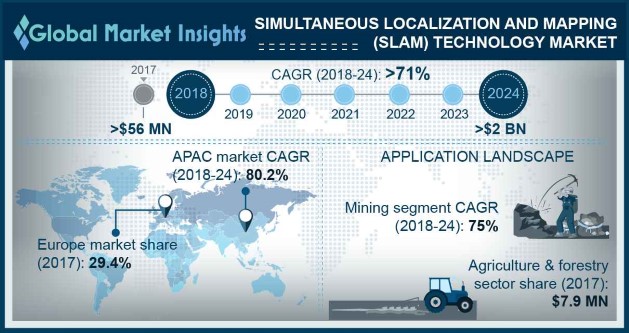Home > Media & Technology > Information Technology > IT Software > Simultaneous Localization and Mapping (SLAM) Technology Market
Simultaneous Localization and Mapping (SLAM) Technology Market Size
- Report ID: GMI2928
- Published Date: Sep 2018
- Report Format: PDF
Simultaneous Localization and Mapping Technology Market Size
Simultaneous Localization and Mapping (SLAM) Technology Market size was estimated to be over USD 56 million in 2017 and is anticipated to grow at a CAGR of over 71% from 2018 to 2024.

The simultaneous localization and mapping technology market is driven by the growing complexities in mapping, keeping track of the users’ location along with simultaneously updating the surrounding map. Landmark characterization, nonlinearity, and data association are the various issues faced for achieving a robust and practical SLAM implementation. Over the last decade, a rapid progress has been made in this field to overcome the challenges by developing some compelling applications of SLAM methods. The SLAM technology enables mobile robots to build a map of their surroundings and use the same map to compute their location, accelerating the adoption rates.
The rapid growth in the use of SLAM technology from various industries, mainly autonomous vehicles and augmented virtual reality, has resulted in its expansion across the globe. Various companies are entering into strategic partnerships and collaborations to expand their product offerings with the inclusion of the SLAM technology. For instance, in September 2018, Fieldbit entered into a partnership with InfinityAR for R&D in the AR smart glasses technology. The two companies are jointly working toward developing an integrated solution for the field service industry by integrating InfinityAR’s SLAM and AR software engine with Fieldbit’s platform for remote assistance. This new SLAM-based solution will serve the needs of the field service organizations by using hands-free solutions for viewing the technical information.
| Report Attribute | Details |
|---|---|
| Base Year: | 2017 |
| Simultaneous Localization and Mapping Technology Market Size in 2017: | 56 Million (USD) |
| Forecast Period: | 2018 to 2024 |
| Forecast Period 2018 to 2024 CAGR: | 71% |
| 2024 Value Projection: | 2 Billion (USD) |
| Historical Data for: | 2013 to 2017 |
| No. of Pages: | 200 |
| Tables, Charts & Figures: | 415 |
| Segments covered: | Motion, Platform, Autonomous Vehicle, Application and Region |
| Growth Drivers: |
|
| Pitfalls & Challenges: |
|
The adoption of automation is making the industrial functioning more efficient with reduced defects. Automation systems coupled with innovative technologies are being set up in leading industrial sectors including mining, automobile, manufacturing, and military. There is an increasing adoption of 3D machine vision due to a rise in the demand for 3D object monitoring in industrial applications. The introduction of SLAM technology into these systems assists in improving the accuracy of the systems by delivering enhanced solutions. The SLAM technology enables robots to navigate autonomously through the environment, eliminating the problem of localization in unknown environments. Furthermore, with the ongoing research in this field, the SLAM technology will provide enhanced benefits to the industrial solutions, augmenting the entire business functioning.
